Is your beloved canine companion constantly scratching, suffering from hair loss, or experiencing persistent itchy skin? These uncomfortable symptoms often point to underlying allergies. While commercial dog foods can sometimes exacerbate these issues, transitioning to a carefully prepared homemade dog food for allergies and sensitive stomach can be a game-changer. By customizing their diet with wholesome ingredients, you can effectively address specific dietary needs, soothe irritated skin, and significantly alleviate discomfort. This article will delve into the common causes and signs of canine skin allergies, highlight the profound benefits of a homemade diet, and provide you with 10 top-tier homemade dog food recipes designed specifically for itchy skin. We’ll also equip you with practical tips for a smooth transition, helping your dog find relief from conditions like hot spots, ear infections, and flea allergy dermatitis. These recipes offer general guidance; remember to adjust portions to approximately 2% of your dog’s body weight daily, tailoring protein sources and overall intake to their unique dietary requirements.
What Causes Skin Allergies in Dogs and How to Identify Them
Skin allergies in dogs are a widespread issue, triggered by a variety of environmental and dietary factors. Common culprits include food allergens (such as certain proteins or grains), flea saliva, dust mites, pollen, and even contact irritants. Identifying the specific allergen can be challenging but is crucial for effective management.
Symptoms typically manifest as:
- Incessant scratching or licking: Especially around the ears, paws, and base of the tail.
- Hair loss: Often patchy, resulting from excessive scratching or licking.
- Red, inflamed skin: Known as dermatitis, which can appear as hot spots.
- Skin infections: Bacterial or yeast infections can develop due to damaged skin barriers.
- Recurring ear infections: Frequent head shaking, ear discharge, or odor can be a sign.
- Gastrointestinal issues: Vomiting or diarrhea may accompany food allergies.
Prompt identification and intervention are key to alleviating your dog’s discomfort. Beyond dietary changes, incorporating soothing grooming products, such as specialized sprays or homemade dog food for sensitive skin grooming wipes, and making environmental adjustments can also help reduce itchiness.
Key Nutrients for Dogs with Allergies
When formulating homemade dog food recipes for itchy skin, it’s vital to focus on nutrients that actively promote skin health and mitigate allergic responses. These nutritional powerhouses include:
- Omega-3 Fatty Acids: Abundant in fish oils (salmon, sardine) and flaxseed, these essential fatty acids are renowned for their anti-inflammatory properties, which can significantly reduce skin irritation and improve coat quality.
- Antioxidants: Found in vibrant fruits and vegetables (berries, leafy greens), antioxidants combat oxidative stress and support a robust immune system, helping to minimize allergic reactions.
- Novel or Lean Proteins: Proteins like turkey, venison, duck, or lamb are often well-tolerated by dogs with sensitivities, as they are less likely to trigger allergic responses compared to common proteins like chicken or beef, which are often found in commercial pet foods.
- Soluble Fibers: Ingredients such as pumpkin or sweet potatoes aid in digestion and promote a healthy gut microbiome, which is closely linked to overall immune function and reduced inflammatory responses.
The Benefits of Homemade Dog Food for Allergies and Itchy Skin
Switching to homemade dog food offers a multitude of advantages for dogs battling allergies and persistent itchy skin. Unlike many commercial kibbles that can contain hidden allergens, artificial additives, and questionable fillers, a homemade diet provides complete control over every ingredient. This allows you to eliminate known triggers and create customized meals tailored to your dog’s precise needs. By embracing real dog food, you can help avoid common issues such as:
- Elimination of Potential Allergens: You can sidestep common culprits like corn, soy, wheat, and specific protein sources that might trigger reactions.
- Improved Skin and Coat Health: The rich supply of essential fatty acids and antioxidants in fresh ingredients promotes a healthier skin barrier, reduces inflammation, and results in a shinier, less itchy coat.
- Enhanced Immune System Support: A diet rich in natural vitamins, minerals, and probiotics from whole foods can bolster your dog’s immune system, making them more resilient to allergens.
- Reduced Reliance on Medications: Many owners report a decrease in the need for allergy shots or medications once their dog transitions to a suitable homemade diet.
- Better Digestion: Fresh, easily digestible ingredients often lead to improved gut health, which is intrinsically linked to a stronger immune response and reduced allergic symptoms.
List of 10 Best Homemade Dog Food Recipes for Allergies:
1. Turkey and Sweet Potato Delight
This recipe is a fantastic starting point for dogs with sensitive stomachs and itchy skin, combining lean protein with a soothing, fiber-rich carbohydrate.
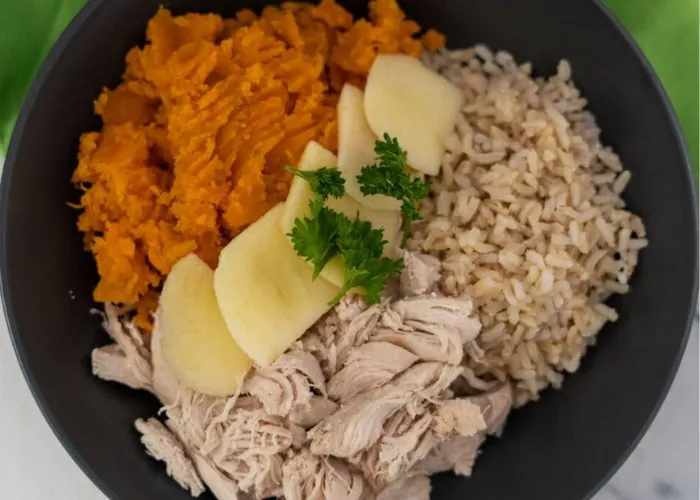 Cooked turkey and mashed sweet potatoes mixed with peas for a homemade dog meal
Cooked turkey and mashed sweet potatoes mixed with peas for a homemade dog meal
Makes 2 cups of food.
Ingredients:
- 1 cup cooked and ground turkey
- 1/2 cup mashed sweet potatoes
- 1/4 cup cooked peas
- 1 tablespoon olive oil
Instructions:
- In a bowl, combine the cooked and ground turkey, mashed sweet potatoes, and cooked peas.
- Drizzle the olive oil over the mixture and mix well.
- Serve the meal to your dog, ensuring it is at an appropriate temperature.
2. Salmon and Quinoa Medley
Rich in omega-3 fatty acids, salmon is excellent for skin health, while quinoa offers a complete, gluten-free protein source.
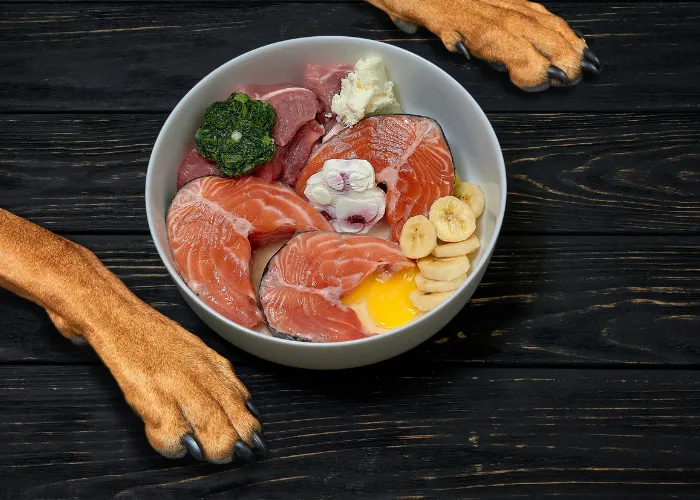 Flaked salmon and quinoa mixed with chopped carrots and green beans for a healthy dog meal
Flaked salmon and quinoa mixed with chopped carrots and green beans for a healthy dog meal
Makes 2 cups of food.
Ingredients:
- 1/2 cup cooked salmon, flaked
- 1/2 cup cooked quinoa
- 1/4 cup steamed carrots, chopped
- 1/4 cup steamed green beans, chopped
Instructions:
- In a bowl, combine the cooked salmon, cooked quinoa, steamed carrots, and steamed green beans.
- Mix the ingredients thoroughly until well combined.
- Allow the meal to cool before serving it to your dog.
3. Beef and Pumpkin Stew
This hearty stew offers a blend of protein and the digestive benefits of pumpkin, ideal for sensitive tummies and skin.
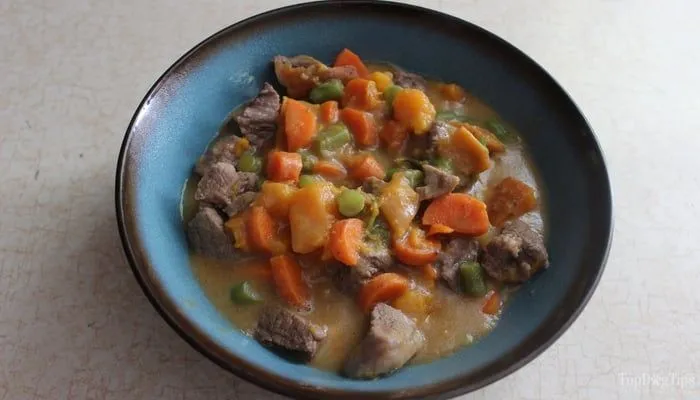 Hearty beef and pumpkin stew with rice and spinach in a bowl, perfect for homemade dog food
Hearty beef and pumpkin stew with rice and spinach in a bowl, perfect for homemade dog food
Makes 1 1/4 cups of food.
Ingredients:
- 1/2 cup cooked and ground beef
- 1/4 cup pureed pumpkin
- 1/4 cup cooked brown rice
- 1/4 cup chopped spinach
Instructions:
- In a saucepan, combine the cooked and ground beef, pureed pumpkin, cooked brown rice, and chopped spinach.
- Heat the mixture over low heat, stirring occasionally, until heated through.
- Let the stew cool down before serving it to your dog.
4. Chicken and Rice Casserole
A classic, easily digestible combination, this casserole provides gentle nutrition. However, if your dog shows sensitivity to chicken, consider substituting with another lean protein.
Makes 1 1/4 cups of food.
Ingredients:
- 1/2 cup cooked and shredded chicken
- 1/4 cup cooked white rice
- 1/4 cup steamed broccoli, chopped
- 1/4 cup grated carrots
Instructions:
- Preheat the oven to 350°F (175°C).
- In a baking dish, combine the cooked and shredded chicken, cooked white rice, steamed broccoli, and grated carrots.
- Mix the ingredients well and spread them evenly in the baking dish.
- Bake the casserole for approximately 20 minutes or until heated through.
- Allow it to cool before serving it to your dog.
5. Lamb and Lentil Stew
Lamb is often a novel protein choice, making this stew suitable for dogs with sensitivities to more common meats. Lentils add a good source of fiber.
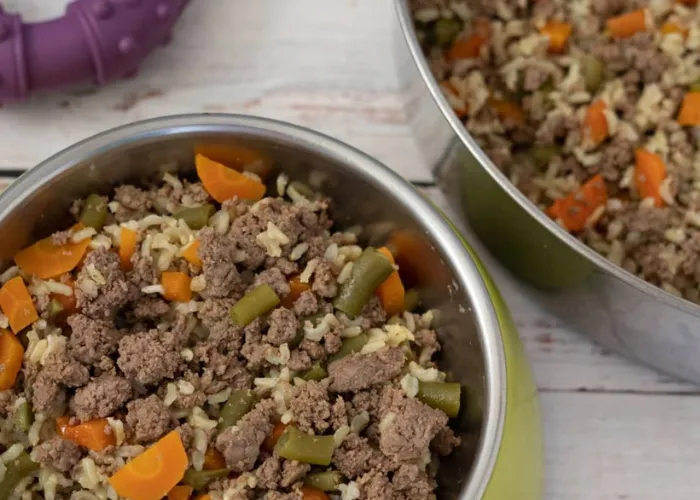 Cooked ground lamb and lentils mixed with pureed sweet potatoes and zucchini for dog stew
Cooked ground lamb and lentils mixed with pureed sweet potatoes and zucchini for dog stew
Makes 1 1/4 cups of food.
Ingredients:
- 1/2 cup cooked and ground lamb
- 1/4 cup cooked lentils
- 1/4 cup pureed sweet potatoes
- 1/4 cup chopped zucchini
Instructions:
- In a saucepan, combine the cooked and ground lamb, cooked lentils, pureed sweet potatoes, and chopped zucchini.
- Heat the mixture over low heat, stirring occasionally, until warmed.
- Let the stew cool down before serving it to your dog.
6. Venison and Sweet Pea Blend
Venison is a highly hypoallergenic protein, making this an excellent option for dogs with severe allergies. Coconut oil adds beneficial medium-chain triglycerides.
Makes 1 cup of food.
Ingredients:
- 1/2 cup cooked and diced venison
- 1/4 cup cooked sweet peas
- 1/4 cup cooked quinoa
- 1 tablespoon coconut oil
Instructions:
- In a bowl, combine the cooked and diced venison, cooked sweet peas, cooked quinoa, and coconut oil.
- Mix the ingredients thoroughly until well combined.
- Allow the blend to cool before serving it to your dog.
7. Whitefish and Carrot Mix
Another great source of omega-3s, whitefish combined with carrots provides a light and digestible meal option for sensitive dogs. This recipe aligns well with the principles of providing highly digestible, nutrient-rich foods that can also be considered similar to what one might find in a barf diet for dogs in terms of whole, unprocessed ingredients.
Makes 1 cup of food.
Ingredients:
- 1/2 cup cooked and flaked whitefish
- 1/4 cup steamed carrots, mashed
- 1/4 cup cooked brown rice
- 1 tablespoon fish oil
Instructions:
- In a bowl, combine the cooked and flaked whitefish, steamed carrots, cooked brown rice, and fish oil.
- Mix the ingredients thoroughly until well combined.
- Ensure the mixture is at an appropriate temperature before serving it to your dog.
8. Turkey and Oatmeal Bake
Oatmeal is a gentle grain that can be well-tolerated by many dogs, offering a good source of soluble fiber to aid digestion and promote gut health.
Makes 2 cups of food.
Ingredients:
- 1 cup cooked and shredded turkey
- 1/2 cup cooked oatmeal
- 1/4 cup cooked green peas
- 1/4 cup grated zucchini
Instructions:
- Preheat the oven to 350°F (175°C).
- In a mixing bowl, combine the cooked and shredded turkey, cooked oatmeal, cooked green peas, and grated zucchini.
- Mix the ingredients well and spread the mixture evenly in a baking dish.
- Bake for approximately 25 minutes or until heated through and lightly browned.
- Allow it to cool before serving it to your dog.
9. Duck and Green Bean Delight
Duck is an excellent novel protein, often recommended for dogs with various food sensitivities. Flaxseed oil adds another layer of omega fatty acid benefits.
Makes 1 cup of food.
Ingredients:
- 1/2 cup cooked and shredded duck
- 1/4 cup cooked green beans, chopped
- 1/4 cup cooked quinoa
- 1 tablespoon flaxseed oil
Instructions:
- In a bowl, combine the cooked and shredded duck, cooked green beans, cooked quinoa, and flaxseed oil.
- Mix the ingredients thoroughly until well combined.
- Ensure the mixture is at an appropriate temperature before serving it to your dog.
10. Homemade Bone Broth
While not a complete meal, bone broth is a highly nutritious additive that can significantly boost your dog’s gut health and provide essential minerals. It’s incredibly soothing for the digestive tract and can aid in reducing inflammatory responses throughout the body.
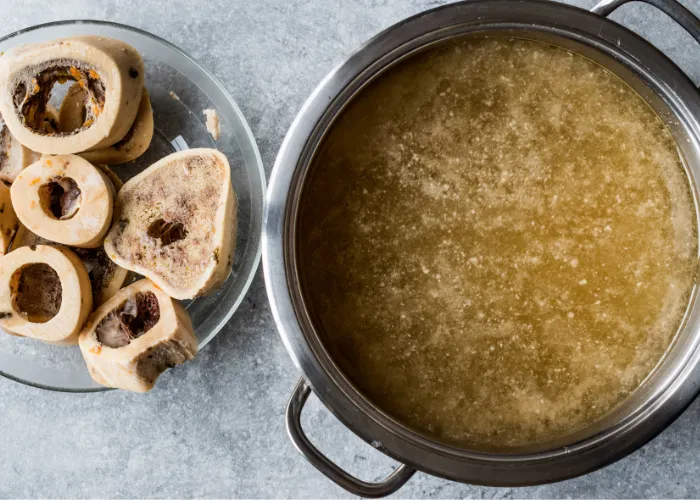 Rich, amber-colored homemade bone broth in a clear glass jar, with raw bones visible
Rich, amber-colored homemade bone broth in a clear glass jar, with raw bones visible
This recipe is an additive to your dog’s meal.
Ingredients:
- 2 pounds of raw bones (such as beef or chicken)
- Water
- Optional: Vegetables like carrots and celery
Instructions:
- Preheat the oven to 400°F (200°C).
- Place the raw bones on a baking sheet and roast them in the oven for 30 minutes to enhance flavor.
- Transfer the bones to a large pot and fill it with enough water to cover the bones completely.
- If desired, add vegetables like carrots and celery for additional flavor.
- Bring the mixture to a boil and then reduce the heat to a simmer.
- Allow the broth to simmer for 8-24 hours to extract the nutrients from the bones.
- Strain the broth to remove any bone fragments or vegetables.
- Once cooled, serve the bone broth as a delicious and nutritious addition to your dog’s meals.
Tips for Switching to Homemade Dog Food to Reduce Itching and Allergic Reactions
Transitioning your dog to a homemade diet requires careful planning and patience to prevent digestive upsets and ensure their nutritional needs are met.
- Gradual Introduction: Start by mixing a small amount of the new homemade food with their current diet, slowly increasing the homemade portion over 7-10 days. This allows their digestive system to adjust.
- Monitor Closely: Observe your dog for any changes in stool consistency, energy levels, or allergy symptoms. If any adverse reactions occur, revert to the previous diet and consult your veterinarian.
- Nutritional Balance: While these recipes are a great start, ensuring a complete and balanced diet long-term is critical. This might involve adding a veterinary-approved supplement to provide all necessary vitamins and minerals. Consult with your veterinarian or a veterinary nutritionist to tailor the diet to your dog’s specific health profile, especially if dealing with severe homemade dog food for dogs with allergies or other medical conditions.
- Batch Cooking: Prepare larger batches of food and freeze individual portions for convenience, making mealtime easier.
- Ingredient Rotation: To prevent new allergies from developing, occasionally rotate protein sources (e.g., switch from turkey to duck or lamb) if your dog tolerates it well.
Conclusion
Homemade dog food provides a powerful, natural, and effective solution for dogs suffering from allergies and chronic itchy skin. By understanding the common causes and symptoms of canine skin allergies, focusing on key anti-inflammatory and gut-supportive ingredients, and meticulously preparing these top 10 homemade dog food recipes, you can dramatically alleviate your dog’s discomfort. A thoughtful approach to their diet promotes a robust immune system, fosters healthier skin, and significantly reduces the risk of secondary skin infections. Remember, a successful transition to a homemade diet demands patience, consistency, and, most importantly, close consultation with your veterinarian to ensure all of your dog’s specific dietary and health requirements are met. Your furry friend deserves a life free from incessant itching, and a tailored homemade diet can be the key to their comfort and well-being.
